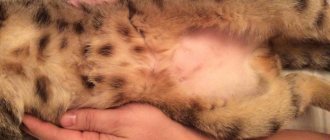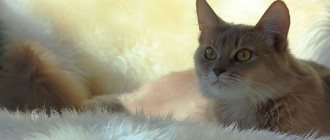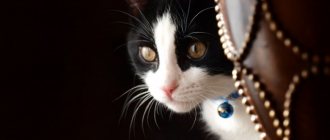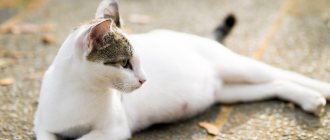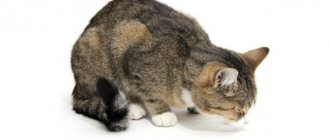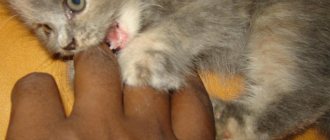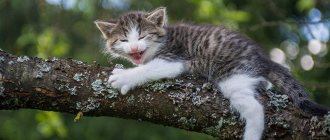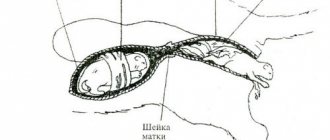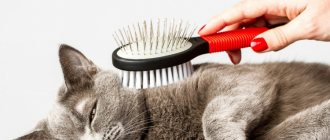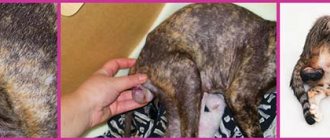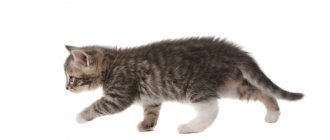Cats are clean and tidy creatures. They regularly lick their fur all over their body, spending up to 10% of their waking time doing this activity. By washing, cats solve several problems at once:
- Cleansing from dust and foreign odors that are absorbed into hairs.
- Thermoregulation - moistened skin, cleared of excess lubricant, breathes better.
- Relieving anxiety - massage and fingering of its fur calms the animal.
The rough tongue of cats is designed in such a way as to comb hairs, collecting foreign microparticles. And the cat’s immune system easily copes with digesting a small amount of dirt that enters the body when licking.
The problem may be the wool. The dead hairs, pulled into the mouth by the tongue, are swallowed by the cat. Under normal conditions, they are excreted from the body in the stool. Sometimes, 1-4 times a month, a cat may vomit hairballs. This happens if undigested fiber accumulates in the pet’s body. Usually the cat regurgitates cylindrical pellets along with mucus and sometimes food debris. This phenomenon is completely normal.
Sometimes a cat cannot regurgitate its fur. You may notice her opening her mouth, coughing, gagging, trying to help herself with her paws, but nothing else happens. Alarming symptoms may include:
- refusal of food;
- lethargy or restless, fidgety behavior;
- dry spasmodic cough;
- hardening of the abdomen;
- dry, unkempt coat, refusal to wash;
- temperature increase;
- increased regurgitation of small hairballs;
- noticeable wool fibers in the stool.
vitamins for cats against hair loss
What causes cats to burp?
There may be several reasons for regurgitation
:
- Cat after lambing
. When the time comes to introduce the little cubs to the main food, the mother cat regurgitates the digested food and feeds it to the kittens. In this way, the stomachs of babies, which are not yet adapted to rough food, get used to digesting meat. Rejection is not a cause for concern here. - Pregnancy
. At the beginning of pregnancy, a cat regurgitates food, and the reason for this is banal toxicosis. Food rejection is also possible in the first few days after lambing. - Overeating at speed
. If a cat greedily fills its stomach out of hunger, regurgitation is often observed after eating to relieve heaviness in the stomach. This happens in homes where there are several pets, and everyone strives to have time to grab their portion. It happens that a cat, having swallowed food hastily, secretly regurgitates the food somewhere in a secluded corner and re-absorbs it calmly. - After sterilization
(castration). Pushing out food occurs if the animal has eaten before it has fully recovered from anesthesia. - Shaking in transport
. If your pet has eaten shortly before traveling, he may vomit this food along the way. - Increased carbohydrate content in food
. Food that is heavy in this sense may not be absorbed into the cat’s gastrointestinal tract and will be rejected. - Poor quality or expired food
. The cat’s body cannot digest it and pushes such food out. - Hairballs
. When licking a fur coat, a cat swallows a lot of fur, which settles in their stomach and forms into dense clumps. Periodically, the animal makes attempts to regurgitate them back in order to cleanse the stomach and intestines. If this happens 1-4 times a month, this is normal. - Foreign object
. If something foreign is stuck in the pet’s throat (especially something long, like a thread, New Year’s rain, etc.), the cat tries to push out the foreign body, which, once caught, is not swallowed or spit out, but causes a gag reflex.
These are the reasons that cause one-time rejection, but if this happens often, and even more so if there is a general deterioration in the condition, pushing out food resembles vomiting - it’s time to urgently contact a veterinarian.
Causes of vomiting in cats
As you know, cats are very clean animals. They devote about ten percent of their waking time to personal hygiene. Naturally, while licking her fur coat until it shines, the cat swallows a certain amount of lint. They enter the stomach and gradually accumulate there, forming hard lumps. Then periodically the animal vomits them.
Another interesting point. It turns out that only domestic cats regurgitate fur. This phenomenon is completely unfamiliar to wild animals, since the food they feed on contains a lot of coarse fibers. The latter act, so to speak, as a “brush”, and the hairs gradually come out naturally, without accumulating in the digestive organ and without forming lumps.
The main reasons that can cause a cat to vomit and vomit are the following:
- irritation of the mucous membrane of the pharynx and stomach by mechanical objects can occur due to accidentally swallowed inedible objects, such as children's hair ties, small toys; some cats do not hesitate to “pick around” in the trash can, managing to accidentally swallow something;
- An important factor for the occurrence of vomiting is swallowed hair, which enters the stomach during licking - this is especially typical for cats of long-haired breeds;
- improper heavy feeding or overfeeding of the cat;
- poor quality feed;
- the presence of an infectious disease;
- helminthic infestation;
- diseases of the gastrointestinal tract, liver of a non-infectious nature (gastritis, intestinal blockage with foreign objects, torsions, etc.);
- increased intracranial pressure;
- injuries;
- loads on the vestibular apparatus (so-called “seasickness”);
- chemical poisoning.
Most often, a cat vomits fur. Cats regularly clean themselves by licking their fur. Gradually, a voluminous hairball accumulates in the animal’s stomach, which causes vomiting (in this case, a tight lump is noticeable in the vomit).
This type of vomiting is part of a pet’s normal life and occurs every month. In some cases, the hairball becomes too large and leads to gastrointestinal problems (this happens in long-haired cats).
To avoid such complications, it is recommended to give pets special preparations (pastes) that help the animal get rid of eaten hair.
Weed also belongs to the auxiliary means. Be sure to grow homemade grass for your favorite purrs! What other reasons cause the gag reflex?
Medical intervention
Attentive owners know very well where the local veterinary clinic is located and regularly visit it with their pet. A medical examination is necessary for a purr, but many medical interventions in a cat’s life have certain consequences. One of these consequences is vomiting.
After operation. Any surgical intervention by doctors aimed at an animal requires anesthesia. Each cat is individual and responds differently to the use of sedatives.
The anesthesia administered to animals is different from the anesthesia used for humans. Fluffies are given drugs that suppress sensitivity. During operations, the eyes of cats remain open.
No qualified veterinarian can determine how a cat will recover from anesthesia. Some purrs come to their senses within an hour after surgery and begin to lead an active life, while others recover for a long time, painfully, with nausea and profuse vomiting.
The main thing you need from the owner is not to be scared. To understand that everything is in order with your beloved domestic troublemaker, shine a flashlight into his eyes. Hold your eyelids so that the cat does not instinctively close his eyes. When exposed to light, a cat's pupils (even those in an unconscious state) dilate.
If the pupils do not react, you should sound the alarm and take your pet back to the clinic. In other cases, provide rest to the purr recovering from anesthesia. At this time, cats' heart rate slows down and blood circulation decreases. What do we have to do:
- Cover the animal with a warm terry towel.
- Massage your furry's paws to improve blood circulation.
- If the cat leaves after sterilization, do not place it on chairs, sofas, or good beds (or lay waterproof diapers for animals under it). After castration, cats spontaneously pass smelly urine - this is the remains of hormones.
- When the cat wakes up, take it in your arms and warm it with your own warmth.
Vomiting after anesthesia is common. The cat may vomit bile (if the animal does not eat before the operation). Do not force water/feed a weakened animal. Kotofey himself will decide when to eat. In difficult times, a pet needs only peace, warm conditions and the care of a loving person.
Vaccination. Purrs must be regularly vaccinated against dangerous diseases. Modern veterinarians use the highest quality drugs that do not cause dangerous consequences in animals. But complications are possible. After vaccination, cats begin to vomit for a number of the following reasons:
- Kotofey was vaccinated during an illness.
- There is an allergy to a component of the vaccine.
Slight vomiting, loss of appetite, fever, and lack of interest in food are observed in a vaccinated pet in the first 2-3 days after vaccination. This is fine. But, if vomiting continues for a long time, and other symptoms intensify, rush to the vet!
Such consequences are evidence of hidden diseases that became more active after vaccination.
Vomiting due to natural causes
Pregnancy. A pregnant cat almost always feels sick and vomits. When a cat's expectant mother is expecting a new baby, her uterus enlarges significantly. The growing organ compresses and displaces the internal parts of the body.
The constricted stomach reacts with nausea and vomiting. During pregnancy, a real hormonal riot occurs in the cat's body, which also affects the state of well-being.
After giving birth, the cat vomits due to eating placenta (if the purr ate too much of it). At this time, the animal also experiences diarrhea. Such symptoms disappear after 1-2 days. Otherwise, you should seek help from a doctor.
Representatives of the cat family have a curious use of the gag reflex - feeding newborn kittens. A nursing mother cat, feeding her babies with semi-digested food, accustoms the little ones to eating the main food of predators - meat.
Continuation of the family. Every animal strives to procreate. These urges are inherent in nature at the genetic level. Your pet periodically goes into heat. Puberty comes at different times.
The earliest heat (at the age of 3-4 months) occurs in cats of Abyssinian and Oriental breeds. But a Sphynx cat first encounters the call of nature at 6-7 months.
But regardless of the onset of estrus, the female should be born at the age of 10-11 months. Fluffies come into heat 2-3 times a year (the British and Scottish breeds are less likely to torment the owner with the whims of behavior during this period).
During estrus (especially in the estrus stage), the animal may vomit. Estrus is immediate estrus; during this period, the animal’s hormonal levels change dramatically. A violent surge of hormones causes gag reflexes. Vomiting during estrus is rare and stops after mating.
From overeating. Vomiting of undigested food is normal. Some purrs are gluttonous – don’t overfeed them! Fluffy gluttons come out with excess food after eating after 20-30 minutes. “Vomitive food” is vomited into undigested pieces covered with a thin film.
Purr vomits if a curious cat swallows a thread, chews the remains of a newspaper, paper, chews and swallows parts of toys. Cats are curious creatures and taste everything. This reflex goes away after an hour, and the animal again becomes active and alert.
Keep an eye on the fluffy one so that the cat does not eat bones or feast on dangerous products (medicines, pesticides). And then the owner will encounter vomiting consequences much less often.
Vomiting due to illness
The gag reflex accompanies many feline diseases. How to understand that your pet is overtaken by a disease and dangerous nausea? Associated signs and symptoms tell the story of a disease. What ailments cause vomiting?
Viral infections. Viruses cause severe diseases in pets, leading to death. The sources of fatal diseases are sick animals and potentially dangerous virus-carrying animals (they excrete microbes in excrement, urine, saliva).
The most dangerous viral diseases in cats are rabies, herpes, calicivirus and coronavirus infections. Aujeszky's disease, feline immunodeficiency and panleukopenia.
The spread of diseases is facilitated by the cohabitation of healthy animals with sick ones and participation in exhibitions (if the animals are overcrowded). The cat gets sick from poor nutrition, long trips and when walking outside on its own.
Dangerous symptoms:
- A sick animal does not eat anything.
- Purr sneezes and coughs heavily.
- Profuse vomiting with blood clots begins.
- Profuse salivation. The cat is choking on saliva.
- A sick cat is lethargic, she does not play, she lies all the time.
Gastrointestinal diseases. A wide range of symptoms are observed in case of stomach diseases in mustachioed pets. With gastrointestinal pathology, the animal constantly feels sick and vomits profusely. A sick pet loses weight despite having a normal appetite.
You can understand that a cat has lost weight by feeling the spine - when it loses weight, it stands out in all anatomical features.
Vomiting in gastrointestinal diseases is a constant symptom. Blood, bile, food debris, and hairballs are found in the vomit. Some animals stop eating completely and don't drink anything, while others eat constantly.
The sick animal vomits heavily. Another extreme also occurs – constipation. The unfortunate pet cannot go to the toilet for several days. This occurs due to large clumps of hair and foreign objects entering the stomach (they clog the organ). This phenomenon leads to the development of intestinal obstruction and death of the animal.
Differences between vomiting and regurgitation
If immediately after regurgitation the cat behaves calmly and naturally, there is nothing to worry about, this is not vomiting as such. You can distinguish vomiting from regurgitation of hair or food by the following signs:
- the process is painless, not painful;
- general condition does not worsen, there are no signs of disease;
- The cat sometimes provokes regurgitation itself as needed.
Unlike regurgitation, vomiting is accompanied by more alarming manifestations both in the state of the animal’s health and in the way this rejected mass looks:
- Thick, dark brown vomit can be caused by a tumor, ulcer, foreign object, kidney failure, or gastrointestinal disease.
- Bright scarlet inclusions indicate bleeding in the esophagus or mouth.
- White foam. It is not dangerous if done once (means that the cat ate on an empty stomach, and as a result, gastric juice, air and mucus were released). It's a bad symptom if it happens often.
- Yellow vomit indicates bile entering the stomach and irritating its mucous membrane, problems with the liver, intestines, or the cat has eaten too many eggs.
- Frequent vomiting of undigested food – problems with the intestines, gall bladder, and liver. Intestinal obstruction or infection is possible.
- Yellow-gray mass - it’s time to change industrial food.
- Green vomit is possible with severe infections or bile or intestinal contents entering the stomach. Not to be confused with regurgitation, when the green color is caused by the cat eating grass.
- Mucus impurities indicate gastritis, helminthic infestations (if there is mucus in the stool), and viral intestinal diseases.
- Vomits like a fountain when the gastrointestinal tract is completely blocked (foreign body, ICP, encephalitis, blood clots, narrowing of the canal, large accumulations of hairballs inside that were not removed in time), when under internal pressure the vomit is pushed out unexpectedly and over a long distance.
These are already very serious signs in which an emergency visit to the veterinarian can be truly vital for the pet.
How to diagnose the cause of a cough
Cats cough much less often than people, and this external symptom is an alarming sign. It is quite possible that this is a sign of a serious illness and your pet needs to be seen urgently by a doctor. At the first stage, the veterinarian’s main task is to exclude or confirm situations that threaten the patient’s life and require emergency intervention.
After all, if, for example, an object that has blocked the respiratory tract or digestive tract is not removed in a timely manner, the animal will soon die; An ignored severe asthma attack or swelling of the throat caused by an allergy can lead to the same sad outcome.
It is also very important to diagnose dangerous infections that can also cause coughing - we are primarily talking about panleukopenia, the so-called feline distemper, epidemics of which often occur among street animals. If your pet is not vaccinated on time, it can easily become infected.
Only a doctor, using various diagnostic methods, can name the cause of the cough.
Without an accurate diagnosis, treatment will not be effective. Therefore, after a clinical examination, the doctor usually immediately prescribes a chest x-ray and a general blood test. Based on the results of these basic studies, additional studies may be prescribed:
- blood biochemistry;
- blood test for immunoglobulin E;
- urine and feces tests;
- cardiography;
- Ultrasound;
- MRI.
Video: why a cat coughs - determine the reasons
The cat choked
Curious cats and playful kittens often suffer from swallowing small inedible pieces from toys or even the most unexpected objects and choking on them. The insidiousness of this trouble also lies in the fact that not in every case the reason lies on the surface.
I know a situation in which a teenage kitten managed to “vacuum up” an ustyuk - a sharp seed from a ripe spikelet. The cough started literally immediately, but the X-ray failed to detect a foreign body. The prescribed treatment did not bring relief, meanwhile, the stuyk had dug somewhere into the wall of the respiratory tract, inflammation and suppuration formed there... The kitten’s condition worsened: in addition to a painful cough, there was already a high fever, and a refusal to eat - a little more, and the baby simply would have lost because of such nonsense. We must pay tribute to the owners - they fought for their pet, changed doctors, and looked for diagnostic methods. Bronchoscopy helped - with its help, it was finally possible to detect this same ostyuka, already completely soaked and half-decomposed. When he was removed, it was no longer difficult to decide on further treatment - the sufferer quickly recovered.
Seeds from such spikelets easily enter the nasopharynx and can be very dangerous for a cat or kitten.
Small objects that a cat can choke on can not only injure the larynx or trachea, but also cause very dangerous problems: asphyxia or obstruction of the esophagus. When the animal tries to clear the airways of foreign objects, a characteristic “choking” cough occurs.
Unfortunately, in many cases the pet cannot solve the problem on his own, and our inept efforts to help him do more harm than good. Objects lodged in the respiratory tract often have to be removed surgically, and resuscitation measures will be required after surgery.
Video: a cat clears its throat, clearing its airways
Respiratory cough
A respiratory cough in a cat can be caused by infectious diseases:
- bacterial;
- viral;
- fungal.
In such cases, it is especially important to identify the cause of ill health at the earliest stages of infection, so that the development of the infection does not lead to serious consequences. Cough is accompanied by the following infectious and inflammatory diseases of cats:
- calcivirosis;
- rhinotracheitis;
- mycoplasmosis;
- laryngitis;
- tracheitis;
- bronchitis.
Avoid contact of your pet cat with sick animals
When diagnosing these ailments, you cannot rely only on cough, since it is already a rather late symptom and occurs in a complicated course, when the upper respiratory tract or lungs become inflamed (pneumonia). At first, the respiratory cough is frequent and quite loud - it is dry, hysterical and can cause suffering to the animal.
Already by the second or third day of illness, the cough becomes more productive, muffled and wet - sputum begins to separate. The process is usually accompanied by additional symptoms:
- suppuration of the eyes;
- nasal discharge;
- general weakness;
- elevated temperature.
Almost all respiratory diseases are transmitted by airborne droplets. It is also possible for infection to be brought into the house on the soles of the shoes of the owner or guests.
Cardiac (heart) cough
In heart failure, attacks of cardiac cough are a concomitant symptom of the disease; You should pay attention to the main signs of the disease:
- shortness of breath;
- lethargy;
- hard breath.
Animals prone to heart disease should always be on your radar
In this case, it is advisable to contact not just a veterinarian, but specifically a veterinary cardiologist, who will prescribe a number of additional studies for the patient, including a cardiogram, and possibly an ultrasound of the heart. The fact is that cardiac cough, especially in the early stages, is very difficult to distinguish from other types of cough.
At first, the misleading impression is created that the cat choked on food or some other small thing; Over time, the intensity of the cough increases. Why is this happening? For various reasons, the myocardium (heart muscle) begins to thicken, which makes it difficult to pump blood in the required volumes. The heart increases in size and puts pressure on the respiratory organs located next to it, irritating the corresponding receptors - and they already signal to the cough center.
Video: a cat has a heart attack
Infestations
In case of helminth infestations, one of the manifestations of which is also often coughing, one should be careful with the use of antiparasitic drugs, since the body, weakened by helminths, can seriously suffer from intoxication if they die en masse. Digestive disorders also occur, and as a result, severe dehydration.
In case of severe infestation, it is better to give drugs under the supervision of a doctor in order to quickly monitor the body’s response.
Allergies and bronchial asthma
The most common cause of cough in cats is considered to be bronchial asthma, when an allergic reaction manifests itself through coughing. The sense of smell in these pets is very sensitive and susceptible to various allergens, among which are the following:
- mold;
- dust;
- pollen;
- cigarette smoke;
- detergents and powders;
- air fresheners, perfumes and deodorants.
Bulk substances, even ordinary flour, can provoke an allergic cough in a cat.
As a rule, the disease first makes itself felt between the ages of three and five years. Many cats suffer from the disease - veterinarians say that “asthmatics” make up up to one percent of the entire population of the Felis silvestris catus species. It must be understood that asthma in cats is a chronic pathology that begins due to an excessive immune response to a certain antigen, which ultimately leads to inflammation of the lower respiratory tract.
Video: Asthma is a common cause of coughing in cats
Oncological pathologies
Tumors and metastasis to the lung tissue can also cause cough. Such pathologies are more often found in older animals over eight years of age.
X-ray of the cat's lungs shows metastases in the lungs, which provokes coughing
Specific diagnostics can detect the presence of oncological tumors in the early stages - in this case, they are amenable to both surgical and drug treatment. If the disease is advanced and a cough indicates the presence of metastases in the lungs, then the animal can be supported using chemotherapy and radiation therapy to prevent the disease from spreading even further.
Traumatic and complex causes of cough
Coughing can also be caused by accumulation of air, fluid or even pus in the chest. If we are talking about liquid, then this phenomenon is called hydrothorax, and various factors can provoke it:
- inflammation;
- allergic reactions;
- heart failure;
- tumors.
To make an accurate diagnosis, it is necessary to perform and examine a puncture of the contents of the chest.
Pneumothorax (accumulation of air in the chest cavity) and pyothorax (accumulation of pus) most often have a traumatic nature - they occur after blows, falls, fights and possible infection.
Cats often fight and injure each other with their claws, causing infection
All these pleuritic phenomena are by no means harmless. The development of pneumothorax occurs very quickly - the air expands the chest and compresses the lungs, the animal loses the ability to breathe and dies from suffocation.
If you suspect any of the described pathologies, you need to do an X-ray examination as soon as possible and, based on its results, apply surgical measures followed by drug therapy.
What to do when spitting up
Although regurgitation is not as dangerous as vomiting, and such nausea after eating is rarely a serious symptom, to reduce the occurrence of such situations, the pet may need help from its owners.
To do this, it is important to provide the animal with proper feeding: food should be fresh, at room temperature. It is necessary to observe the amount of food offered to the cat, as well as ensure the pet’s access to water.
If you are planning a trip, you should not feed your pet several hours before departure. During the journey, the cat regurgitates because the food is literally churned in the stomach and eventually vomited back out.
The body clearly does not accept any food - replace it.
You can try to remove the foreign object yourself, but if it is stuck deep, you should urgently take the cat to the doctor.
If a cat's regurgitation is caused by attempts to push fur out of the stomach, these manifestations can be reduced by regularly brushing the pet's coat and thus removing loose hairs (especially important for long-haired cats and during the molting period). Thanks to this procedure, “fur plugs” accumulate longer, and the animal, regurgitating hairballs, will be less likely to frighten its owners.
Your pet should be examined by a veterinarian at least once a year.
What not to do
When a cat regurgitates all the food one time after eating or simply rejects hairballs from time to time, nothing needs to be done. But even if your pet is vomiting, you should not:
- give human drugs (it’s hardly worth explaining why);
- drink water if it provokes additional attacks;
- give food for a day;
- give water if for some reason the animal has ingested a chemical substance;
- delay contacting a doctor if your cat vomits for more than a day.
Only competent and balanced actions of the owners will eliminate the possibility of complications of existing diseases or the transformation of ordinary food or fur rejection into a more serious problem.
Cats are clean and tidy creatures. They regularly lick their fur all over their body, spending up to 10% of their waking time doing this activity. By washing, cats solve several problems at once:
- Cleansing from dust and foreign odors that are absorbed into hairs.
- Thermoregulation - moistened skin, cleared of excess lubricant, breathes better.
- Relieving anxiety - massage and fingering of its fur calms the animal.
The rough tongue of cats is designed in such a way as to comb hairs, collecting foreign microparticles. And the cat’s immune system easily copes with digesting a small amount of dirt that enters the body when licking.
The problem may be the wool. The dead hairs, pulled into the mouth by the tongue, are swallowed by the cat. Under normal conditions, they are excreted from the body in the stool. Sometimes, 1-4 times a month, a cat may vomit hairballs. This happens if undigested fiber accumulates in the pet’s body. Usually the cat regurgitates cylindrical pellets along with mucus and sometimes food debris. This phenomenon is completely normal.
Sometimes a cat cannot regurgitate its fur. You may notice her opening her mouth, coughing, gagging, trying to help herself with her paws, but nothing else happens. Alarming symptoms may include:
- refusal of food;
- lethargy or restless, fidgety behavior;
- dry spasmodic cough;
- hardening of the abdomen;
- dry, unkempt coat, refusal to wash;
- temperature increase;
- increased regurgitation of small hairballs;
- noticeable wool fibers in the stool.
Why doesn't a cat spit up fur?
If your cat is fine with her appetite and activity, but you don’t see her spitting up her hair, there is no reason to worry.
A strong body with proper nutrition copes with the removal of hair during bowel movements. If your cat usually sheds fur, but has stopped, think about what has changed in her diet. If you have not switched it to special supplements, there is a reason to monitor the animal, perhaps it cannot regurgitate its fur.
When your cat tries but cannot push the hairball out, it may have become too large or stuck.
Your cat often regurgitates hairballs
Hairballs in cats form constantly in the gastrointestinal tract, and this is normal, especially for long-haired individuals. When licking itself, a cat always swallows particles of fur, this is inevitable, but if the lumps do not leave its body and form bezoars, then this threatens with serious problems in the health of the animal.
A cat spits up hair periodically, about once a week, but if this happens daily, and sometimes several times a day, then this indicates an accumulation of caked hair in the esophagus. Normally, regurgitated hairballs look like “sausages”, dense, rolled into a cylindrical roll. Such formations should not cause serious damage to the animal, but sometimes the lumps cake in the gastrointestinal tract and cause gastritis or blockage. It is necessary to prevent such formations, otherwise troubles can become serious.
If a cat, especially a fluffy one, starts vomiting hair, then the reason is its excessive cleanliness and insufficient attention from the owners. Long-haired individuals (Persians) must be combed daily, removing dead hair carefully so as not to injure the delicate skin. Let this become a ritual from the very beginning of acquiring a kitten. A long-haired kitten is taught to brush itself from the first weeks of life, gently, without hurting it. The teeth of the comb should be thick with rounded ends; sharp ones will cause discomfort to the pet, and combing will turn into torture for everyone. Cats remember the unpleasant moments associated with caring for her, and if once she was in pain, then later, at the sight of a comb, she will hide.
Licking for cats is not just a process of tidying themselves up - it is control over natural thermoregulation. The cat calms itself in this way, especially in stressful situations.
Short-haired cats are also prone to ingesting hair, although to a lesser extent than their long-haired counterparts. This problem becomes especially relevant during seasonal molting, as well as in cats with dense and thick coats.
Observe your pet; if he licks himself too often, the room may be too dusty and dirty, with high humidity and temperature. Restless licking accompanied by biting the fur indicates the presence of parasites.
A cause for concern would be frequent regurgitation of hair or if the cat vomits hair. In this case, it is necessary to show the animal to a veterinarian. Possible development
pancreatitis, gastritis or intestinal obstruction.
A large amount of fur in a cat's stomach is indicated by:
- frequent regurgitation;
- constipation or very hard stool with particles of hair;
- vomiting of undigested food;
- bloated stomach, lack of appetite and depressed state.
A dry, intermittent cough that occurs after eating may also develop.
Frequently asked questions to the doctor.
Is there a special food that helps remove hair?
Yes, professional food contains a special formula for hair removal and plant fibers. This provides a balanced diet and helps remove hair naturally. This food is mixed with the main food or given in portions separately.
What does hair removal paste contain?
Special pastes intended for cats contain sweet syrup, oil, and lecithin. Cats usually happily lick this paste, and its regular use ensures timely release of the gastrointestinal tract from hairballs.
What, besides food and pastes, can you give a cat to cleanse its stomach?
Sprouted grass. It is sold in pet stores or grown in the window yourself.
Veterinary
What to do to help your cat
The main thing that is needed is:
- Regular brushing, especially of long-haired breeds with thick undercoat. Do this once a week, and during the molting period - every day or two.
- Give your cat the right food. It includes a healthy diet with minerals for normal coat growth, as well as enzyme and fiber supplements that help your pet's body remove tough debris, including hair. Such additives are malt paste and dry malt bit pads.
- If you have severe symptoms, contact your veterinarian.
Why does a cat often lick itself? Prevention of the problem
Sometimes cats begin to groom themselves more than usual, which can worsen the problem of regurgitation. Reasons for increasing the frequency of hygiene procedures may include:
To avoid trouble, try to help the animal and help normalize the situation. Keep the house clean, do not force your pet to interact closely with other animals, and do not allow guests to pet the cat if he does not want to.
During shedding, comb the coat 2 times a day, depending on the breed. This period is short-lived. If there are a lot of hairs left on the brush, then they need to be removed. The cat is brushed when the brush remains clean. When a lot of hair no longer accumulates on the comb in one procedure, shedding is over. Regular brushing of your pet will help keep your home tidy and will also prevent hair from accumulating in your pet’s body.
What to do if your cat is coughing
Any attentive owner can independently determine the nature of a cat’s cough and even its type. But understanding the reason for what is happening, much less taking a set of measures necessary to heal your pet, alas, will not work at home. This will require a personal examination by a specialist, additional diagnostic tests and equipment that is only available in the clinic.
It is important to understand: a cat’s cough is by no means an independent disease, but only a symptom, “a manifestation of one of a hundred diseases,” as old veterinarians liked to say. You need to look for the cause and eliminate it - and not try to cure the cough itself.
Is it possible to help an animal yourself?
At home, you can only alleviate the cat's condition before visiting a veterinarian. The air in the room where the animal is located should be fresh and humid - ventilate the room, but under no circumstances leave a sick pet in a draft, this will only worsen the problem. Inhalation of steam, which should not be too hot, can bring relief to a cat - this procedure is available at home even without any special equipment.
Try to calm your pet as much as possible. Cats are very sensitive and emotional, sudden attacks can frighten them, causing the cough to intensify and the situation as a whole to worsen. Caress a confused animal - it trusts you and should feel that a loving owner will take care of it.
It is necessary to take a coughing pet to the doctor as soon as possible, because he will only be able to receive real help after a qualified diagnosis. It is also important not to give your cat any medications before visiting the clinic . Firstly, the effect of the drugs will “blur” the symptoms of the disease and complicate the diagnosis. Secondly, cough is not a harmless problem at all; only an experienced specialist has the right to prescribe medications for its treatment, and only if he has clearly determined the reasons for the manifestation of this symptom.
Medical assistance
Provided a clear diagnosis is made and the exact cause of the cough is determined, the doctor can use many modern tools to treat it. But the starting point of any successful healing was and remains an accurate and timely diagnosis.
Table: treatment prescribed for different types of cough
| Cause of cough | General therapy | Drugs |
| Heartworm |
|
|
| Cat flu and other infections |
|
|
| Bronchial asthma |
|
|
| Worm infestations |
|
|
| Traumatic cough |
|
|
| Polyps and tumors |
|
|
Video: treatment of cough in cats
Antitussives
It is strictly prohibited to use antitussive or expectorant drugs independently, without a doctor’s prescription. The wrong choice or inaccurate dosage of the drug may not cure the cat, but, on the contrary, worsen its condition - leading to complications of the disease and dangerous side effects.
But we hope that information about what antitussive drugs are will be useful for every owner. These drugs, according to the nature of their action, are divided into two large subgroups: blocking and expectorant. There are also medications that combine both of these qualities and have a complex effect - these are mainly human medications, and not all of them will benefit a cat.
“Harmless” cough syrups for children (as well as adults) are absolutely not suitable for cats. These pharmacy delicacies are not always useful for people, given the high content of sugar, flavorings, dyes and other improvers. There is definitely no need to give such medications to cats. Products that contain alcohol or codeine are also not suitable for them.
Blocking drugs are good because they quickly relieve the animal from painful and painful coughing attacks. But such medications do not treat its cause, but simply “turn off” the cough center, blocking its functions. The cough is thus masked as a symptom, but the disease is not treated and the situation worsens. Such drugs can only be prescribed as a component of complex therapy, but not on their own.
Expectorant antitussive drugs have proven themselves well in the treatment of coughs of an infectious nature. By liquefying thick mucus and facilitating its elimination, such medications help not only to make the animal’s breathing easier, but also to clear its respiratory tract of pathogenic microflora - bacteria and viruses that have become the causative agents of the disease.
Table: veterinary cough medications for cats
| Drug name | Release form | Action | Approximate price |
| Divopride | Cough tablets for dogs and cats |
| 120 rubles per pack of 50 tablets |
| VetExpert VeTussin | Cough syrup for dogs and cats |
| 100 rubles per bottle of 100 milliliters |
| ZooHealth | Cough tablets for dogs and cats |
| 60 rubles per pack of 20 tablets |
| Helvet Lobelon | Homeopathic antitussive drug for the treatment of respiratory diseases, solution for injection |
| 350 rubles per bottle of 10 milliliters |
Medicinal herbs and cough preparations
Treating a cat’s cough with folk methods and herbs at one’s own discretion, and not on the doctor’s recommendations, can cause no less harm than drug self-medication - it is easy to transfer the disease to a critical stage, but sometimes it is simply impossible to reverse it.
You cannot indiscriminately recommend remedies from a natural pharmacy to treat a cat’s cough - even when using the safest of them, you should largely rely on the experience and advice of a veterinarian you trust. If the doctor does not mind, the natural preparations listed below can be used for kittens and pregnant cats, using them both internally and in the form of inhalations.
Licorice root decoction
An ancient herbal remedy for soothing coughs and removing phlegm. Effective, hypoallergenic.
Ingredients:
- crushed licorice roots - 1 heaped tablespoon;
- purified water - 1 glass.
Dried licorice root must be finely chopped before use.
Application:
- Medicinal raw materials are poured with cold water in the evening and left to infuse until the morning.
- Over low heat, bring the mixture to a boil under the lid.
- Reduce the heat to low and boil the broth for 12–15 minutes.
- Cool and filter.
- Adult animals are given an incomplete teaspoon of decoction three to four times a day, without combining with meals.
Infusion of coltsfoot leaves
One of the most famous medicinal plants with a strong expectorant effect.
Ingredients:
- dry or fresh coltsfoot herb - 1.5–2 teaspoons;
- boiling water - 1 cup.
For infusions, the entire aerial part of the coltsfoot is used, but most often the leaves
Application:
- Rub the medicinal raw material a little in your palms and pour it into a thick-walled (preferably ceramic) bowl.
- Pour freshly boiled water over the prepared coltsfoot, cover tightly with a lid and leave in a warm place for 30–40 minutes.
- Filter the finished infusion and pour into a clean container.
- Give to a sick cat three times a day to improve expectoration, warming the infusion before each dose.
Infusion of plantain leaves
An excellent healing and anti-inflammatory natural remedy; removes phlegm well and promotes tissue regeneration.
Ingredients:
- freshly picked plantain leaves - 1-2 pieces;
- hot water - 0.5 liters.
Whenever possible, use plantain leaves fresh rather than dried.
Application:
- Wash the plantain leaves thoroughly with running water and let them dry.
- Tear the leaves into small pieces - it is better not to use scissors or metal knives for chopping.
- The crushed raw materials can be slightly ground with a pestle in a non-metallic mortar.
- Pour well-mashed plantain leaves with boiled water no hotter than 70 degrees, seal tightly and wrap.
- After complete cooling, strain the infusion.
- Give the cat a teaspoon four to five times a day until complete recovery.
Medicinal plants can provide many benefits if used correctly
Also among the effective natural cough remedies are the following medicinal plants:
- wild rosemary;
- eucalyptus;
- oregano;
- anise fruit;
- birch and pine buds;
- linden flowers;
- elecampane;
- tricolor violet;
- lungwort;
- thyme, etc.
Herbal medicinal raw materials for the treatment of cough in cats are no less effective and safer than many medications, even those made on a natural basis. But the main problem with the use of such drugs in veterinary medicine remains the unpredictability of the animal’s response to a particular plant, especially as part of preparations.
Veterinarians report a large number of allergic reactions that occur in cats during such treatment. Need I say how dangerous this is - for example, in the case when coughing is a symptom of bronchial asthma? Obviously, when choosing useful plants in nature for self-medication, animals are fully guided by instincts and do not make fatal mistakes. And our inept care can too often harm them.
Why is fur in a cat's stomach dangerous?
Hairballs remaining in the animal's stomach cause disease in the four-legged animal. Most hairs accumulate in a cat's stomach during shedding. In order not to harm the health of your pet, you need to know how to help a cat remove hair from its stomach, avoiding undesirable consequences: - hair balls accumulated inside the cat’s stomach lead to disruption of the digestive process; hairballs cause the animal to feel a full stomach; at the same time, the pet consumes a smaller portion of food and does not receive the nutrients it needs; - Rolled hair balls can cause intestinal obstruction in a cat; and when the owner of the animal is faced with the question of how to remove hairballs from the cat’s stomach, he has to solve it in a veterinary clinic and often through surgery; - in long-haired cats, hairs often accumulate below the jaws behind the fangs and penetrate into the gums, causing inflammation; this hair should be removed since the animal cannot remove it on its own.
It happens that a pet independently gets rid of hairballs inside its stomach by regurgitating them. This is a natural process. Therefore, the animal should not be scolded. To understand that a cat has problems associated with the presence of hair in the stomach, you just need to carefully observe it.
Video: how to deal with shedding in cats?
It's easy and interesting to communicate here. Join us!
very good medicine in a tube (photo) cats love it very much, they can lick it directly from the tube, slowly squeeze it out and the cats lick it off themselves, I usually give it to mine once a week, I squeeze out two cm at a time. You can give it to yours more often, you’ll see for yourself, wool will come out naturally, belching will be a thing of the past and he will be very grateful to you.
change the food, my cat is on homemade food and has not burped in 2 years
There is a special paste. buy it at a veterinary clinic! And also plant some grass for the cat. helps too! This is how mine chews it!
Why did you decide that a cat cannot vomit fur? He's vomiting bile. . Take him to the vet and have his liver and pancreas checked. . And Hills is not a panacea... Or rather, it is not a guarantee that nothing will happen. . And what you need from wool is not food, but grass or malt paste.
Have you tried giving grass to a cat, the kind in pots sold in pet stores? usually with the help of it they regurgitate the fur; in general, this is why the animal gnaws it
There are vitamins for dissolving hair, although I don’t believe it, it will probably just go out through the anus. Grass theme my 2 cats 4 of them can sit at a time)
Maybe the vomiting is not due to the presence of hair in the stomach? Moreover, you are giving medications to dissolve fur. Could there be a foreign object in the respiratory tract? Better show it to the vet.
How can you tell if there is fur in a cat's stomach?
The presence of fur in the digestive tract of an animal can be determined by the following signs:
1. Fur that gets into a cat’s stomach leads to a fictitious feeling of fullness. In this case, the cat, heading towards the food bowl, will eat a little and immediately move away. The portion of food eaten will be significantly smaller than usual. And if a hairball is stuck inside the cat’s digestive tract, this will lead to indigestion, prolonged constipation, and therefore to a lack of stool, since the embedded hairball prevents bowel movements.
2. Based on the external condition of the animal, one can judge whether it has hair in its stomach. It becomes noticeable that the cat’s coat looks hard and dull in appearance.
3. If, when examining a cat, you can see that hair is accumulating on its fangs, then it follows that it is also in the stomach.
4. Frequent vomiting in a cat indicates the presence of a large amount of hair in its stomach. It is not uncommon for an animal to vomit during the day or after eating. The animal tries to burp, but to no avail.
5. When a cat accumulates a large amount of hair in its stomach, its behavior changes. The animal develops apathy, lethargy, and increased drowsiness. The pet is always trying to hide somewhere.
Treatment of vomiting in cats
If the act of vomiting occurred once and the cat feels normal, then it is not necessary to see a doctor. In this case, no special treatment is required. If vomiting occurs more than 3 times a day, and the animal looks sick and depressed, then the cat owner should think about what could have caused the vomiting and try to eliminate it, as well as visit a veterinary hospital for consultation with a specialist.
Then proceed as follows:
- The cat is limited in food for 1-2 days.
- To prevent dehydration (which is quite a common occurrence with prolonged and frequent vomiting), instead of water, you can give Regidron solution, according to the instructions, or salted water - 9 g of table salt (about 1 teaspoon) per 1 liter of water.
- In particularly severe cases, the animal may refuse water, in which case it is necessary to inject Ringer's solution.
- If vomiting occurs too often, it is recommended to administer antiemetic drugs (Phenothiazine, Torekan, Paspertin).
- You can use medications that protect the mucous membrane from irritating factors - bismuth preparations.
- If the cause of vomiting is poisoning, then it is recommended to give the cat activated carbon, which is an excellent adsorbent, and also to put in a drip with glucose and ascorbic acid, which perfectly relieve signs of intoxication in the body.
- Antibiotics or sulfa drugs are prescribed only in cases of infections and severe damage to the gastric mucosa.
During treatment and several days after it, in cases where vomiting was the result of problems with the digestive tract or poisoning, it is advisable to put the cat on a therapeutic diet, adhering to simple rules:
- feed in small portions several times a day;
- food should be soft, preferably in the form of puree;
- Introduce meat feed into the diet gradually.
Long-term use of medications to control hairball formation in cats' stomachs is not required. Before using medications, you should always try to find out the cause of hair vomiting and use other methods to control this pathology, such as diet, inert oils, and grooming long-haired cats.
How to help a cat remove fur from its stomach?
Not everyone knows how to remove fur from a cat’s stomach. Hairballs stuck in a cat's digestive tract usually come out in vomit and, less commonly, in feces. But if an animal has difficulty getting rid of hairballs, you should know how to remove hair from a cat’s stomach at home:
1. A walk helps the cat restore its body functions. When a cat walks outside, it can self-medicate by eating the plants it needs that cause vomiting. An animal that does not leave the apartment can heal itself if it gets to a summer cottage, where it walks in the grass and finds something to heal itself.
2. Grass grown at home on the windowsill helps to improve the health of the cat’s body. Most often, oats are sprouted for cats. If it is not possible to take the animal to the country, you should germinate the grass in a flower pot. Seeds of the herb, which stimulates vomiting in cats, are available in pet stores. The seeds are sown in a container that is placed on the windowsill. When the first sprouts appear, the cat will begin to eat them. You can also buy ready-made herbs in the store.
3. Pads for cats relieve animals of excess hairs of fur in the stomach. The pads contain aromatic vegetable oils. Products of this type come in different flavors: beef, chicken, fish. After a cat eats such pads, the oils they contain envelop the walls of the animal’s stomach and promote the removal of fur with feces. Such treats are sold even for cats that are particularly demanding. The best pads that help remove hair from a cat's stomach are Whiskas Anti-Hairball.
4. Paste is offered in pharmacies and pet stores. It should be added to animal feed. Cats like the paste for its taste and smell. It should be noted that in some cats it causes constant and severe vomiting.
5. Phytomines are used to remove hair from the stomach of an animal. In addition to the hairball, these drugs can remove pieces of paper and other objects lodged inside the cat's intestines. Phytomines cope remarkably well with obstruction of the digestive organs. They contain medicinal herbs that improve processes in the digestive tract of your pet.
6. Special foods help the animal naturally remove hairballs from the body with feces. For example, Royal Canin Intense Hairball 34. The composition of such food includes oil, which, after the cat eats the food, first coats the stomach area with the intestines of the animal, and then helps to gently get rid of even a large hairball. This is done once a month as a preventive measure or during molting.
You can choose special food for cats that helps remove hair from the stomach in any online store of pet products: - ; - ; - ; —
Do not contribute to the increase in dog and cat populations. Take your pets to veterinary clinics to have them spayed and neutered under anesthesia. Otherwise, there is a very high probability that your cat's kittens or your dog's puppies will end up on the street. Homeless animals suffer from hunger, cold, human cruelty, the teeth of wild animals and fall under the wheels of vehicles. Don't breed unfortunate creatures!
If a cat is coughing, as if it is choking and wants to vomit, this is not a reason to panic. You should not start treating the animal yourself. It is better to pay attention to what other symptoms are observed. You can make a video recording of your pet coughing and visit the veterinary clinic as soon as possible.
Ways to alleviate the plight of a cat and preventive measures
~ feed the cat correctly - good ready-made food or balanced natural food. If a cat eats food from the table, it may develop problems with the liver, kidneys, stomach and intestines.
~ Vaccinate your cat annually against infectious diseases.
~ deworm at least twice a year
~ comb regularly, and if necessary, give the cat a special paste for removing hair, which helps dissolve it and remove it from the digestive tract
~ make sure that the cat does not have access to threads and needles, New Year's tinsel, indoor plants, trash cans, garden and household chemicals. Her toys must be solid, durable and free of toxic materials
~ do not feed a cat sensitive to motion sickness before traveling, but on a long trip offer it small portions of food
~ once a year, give your pet a preventive examination at a veterinary clinic, and if he is over 10 years old, then more often
There are several methods, the use of which will minimize the accumulation of hair in the stomach. With proper care from the owner, the animal will never suffer and will not “earn” serious illnesses due to its cleanliness. What can and should be done?
- Brush your cat regularly, especially if it is a long-haired breed.
- Introduce fiber into the diet, which is abundant in vegetables and herbs (good food always contains it, and if the animal eats from a common table, then the owner needs to take care of this).
- Allow your cat to nibble on grass, which helps remove hair from the stomach. It can be grown right in the house if the pet does not go out for walks.
- Give the animal a special paste with malt that prevents hair from accumulating. As a preventive measure, once a week will be enough, and if the problem has already worsened and hairballs appear frequently, it is recommended to take the product for 21-30 days.
If a cat spits up hair rarely, this is, in principle, the norm. Unfortunately, this is the fate of pets cut off from their natural environment. However, in cases where regurgitation occurs frequently and there are accompanying alarming symptoms, the situation cannot be ignored. The cat needs help, and often it cannot be done without a doctor.
It is an undeniable fact that it is better to prevent a disease than to treat it, therefore, to prevent vomiting, you must follow simple rules:
- Feed the cat only with high-quality food, balanced in vitamins and minerals;
- annual vaccination against infectious diseases;
- do not forget about giving your cat anthelmintic drugs quarterly;
- combing the cat's hair and giving medications that will help gently remove the hair from the body;
- keeping bedding and all animal care items clean;
- Keep small household items away from cats so that they cannot get them.
Author of the article: Marina Chuprinina, veterinarian, specialization parasitologist-bacteriologist, especially for Kota Obormot.
Since long-haired cats shed significantly more hair, regular brushing can help reduce the amount of hair they ingest. If this does not help, it may be useful to cut the cat like a lion; it will at least temporarily free the stomach from fur.
Studies have shown that frequent feeding of small meals helps improve gastrointestinal motility and reduces the risk of hairballs in the stomach. The use of inert oils can provide a lubricating effect in the stomach and prevent the formation of hair conglomerates.
Owners should be warned against administering such oils with a syringe themselves, as they are tasteless and odorless, so they can get into the trachea. It is preferable to mix them with food. It is also recommended to leave at least one portion of food per day without oil (there is an opinion that the constant use of inert oils reduces the intake of fat-soluble vitamins).
Types of symptoms
A cough means one thing - the cat’s body is trying to get rid of something.
The muscles of the respiratory organs contract and push, at which point the cat coughs. Such attacks are accompanied by other symptoms. The cat is sneezing or wheezing, breathing heavily, and his eyes are watering.
The natural microflora of the throat, esophagus and lungs is disrupted, so the cat develops a cough reflex. The immune system increases the secretion of secretions, directing white blood cells to fight symptoms. Cough has different causes:
- microbes;
- foreign bodies;
- viruses;
- wounds.
But the essence is the same - discharge accumulates, and you need to get rid of it. The cat's body is designed in such a way that when it coughs strongly, it looks like the animal is about to vomit.
When your pet coughs, symptoms vary by:
- 1. Duration: sometimes the condition develops in attacks, in other cases it constantly torments the animal.
- 2. Intensity: mild coughing or coughing so strong that it hurts to look at the cat. The condition may be accompanied by vomiting and snot.
- 3. Sound: the cough can be painful and muffled or loud. In other situations, the cat is constantly breathing heavily.
- 4. Discharge from the mouth and nose: dry coughing is dangerous, but worse when purulent and bloody traces are noticeable.
- 5. Time of manifestation: respiratory disorders worsen either at night or after sleep. For diagnosis, it is important what time of year the cat got sick. Behavior also varies - the animal coughs after hissing or stretching out and pressing itself to the floor. All these points are important for diagnosis.
the cat tries to burp but it doesn’t work, the appetite is preserved
Usually, 2-3 minutes before burping, he begins to howl loudly, and in such a tone as a dog at the moon. He howls for a short time, about 30 seconds, then burps.
I usually grab him when he howls and drag him to the kitchen where the linoleum is. The day before yesterday the cat started howling, I took him away. He seems to begin to feel sick, twitches, but nothing works out for him. Then I see that all his paws are giving way and he is strangely falling, a little on his side. He tries to get up and falls again. Can't stand on his feet at all. This lasted for 3-4 minutes. I tasted his nose - it was dry and warm. Then the cat went under the sofa and didn’t come out for half an hour. After 3 hours the appetite was normal. The coat is shiny. Lately I have been feeding my cat puree made from boiled fish and boiled buckwheat; previously I fed my cat puree made from buckwheat and canned cat food (Gourmet).
The same thing happened again today. He again seemed unable to stand on his feet at the moment of burping and fell onto his stomach. It was as if all his paws had been taken away. The nose is dry and warm, the pupils are dilated, as if he is afraid of something. It passed very quickly, the cat ran under the far corner of the sofa. I gave him a paste to dissolve the wool, but he didn’t eat it. Now he walked around me a couple of times, meowed for the sake of decency (in that tone as if he was asking for food), and again hid under the sofa.
I ran outside and picked some grass for him. I put it next to it. He always adored it, now he won’t even eat it. I washed the grass, put it in the bathroom, and took the cat there. I ate very reluctantly. He returned again and hid under the sofa. Now he walks nearby, his nose is cold and wet again. I didn't throw up.
It’s not a fact that he’s trying to regurgitate fur, maybe he’s just feeling nauseous. Sorry, but it's nauseating. wobbly paws are very bad symptoms. It looks like a heart (mine started out that way). Take him to the doctor urgently, and make sure there is a cardiologist at the clinic.
Your cat is vomiting blood. This may well be a sign of gastrointestinal obstruction. Don't touch his nose
Source
